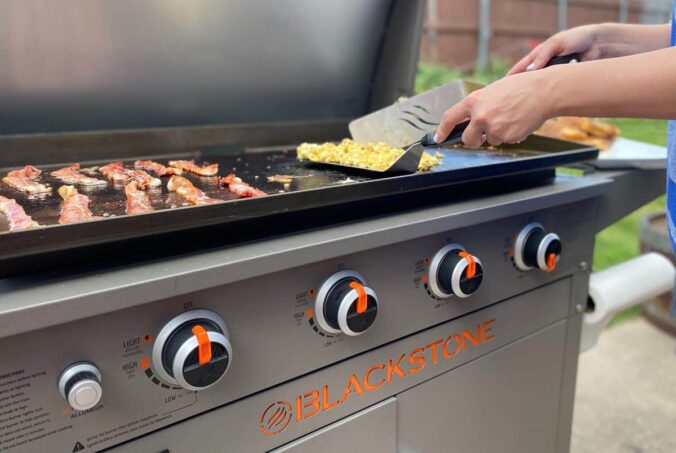Griddles are some of the most versatile cooking appliances, allowing you the flexibility to experiment with different cooking styles. You may be less acquainted with flat-top gas grills than you are with traditional gas grills, so we created this guide to everything you need to know when buying a flat-top gas grill or griddle!
Do griddles require a lot of maintenance?
You may think that high-quality griddles come with high maintenance, but that isn’t true. Griddles require the same degree of maintenance that traditional non-stick pans require. Following cleaning & seasoning steps will give you optimal performance and longevity in your griddle.
How do you season a griddle?
Seasoning is the preparation of steel or cast iron cookware for use. This coats the cookware to prevent rust and creates a natural non-stick cooking surface.
Seasoning is an ongoing process that takes time and repeated use before a griddle develops a shiny, black surface (like your grandmother’s cast iron cookware may have).
Cleaning & seasoning a griddle for the first time:
Blackstone griddles are pre-seasoned with cooking oil to prevent rust and damage during shipping. For first-time use, you should wash the griddle in hot, soapy water. Please note that this is the ONLY time you should use soap on your griddle. Rinse it and dry it completely with paper towels. Then, proceed with seasoning instructions.
Cleaning after each use:
After each use, scrape gently with a spatula and wipe down the surface with a paper towel. If you have tough food residue, you can pour hot water onto the griddle surface and let it boil the residue off. Wipe it off again and dry completely.
Seasoning after use:
Be sure to remove all of the food debris with a spatula or scraper. Apply a generous coating of cooking oil to the griddle surface. Use a paper towel to spread the oil evenly across the surface. Then, allow it to cool down and store it in a cool, dry place.
What is the temperature range for a flat-top grill?
Most griddles have a temperature range of 25-550 degrees Fahrenheit.
What size griddle do I need?
The size of your griddle will play a role in how much you can cook at once, the number of cooking zones, and cooking versatility. To figure out which size is right for your outdoor space, you’ll want to ask yourself three questions:
- How many people do you normally cook for?
- What’s the maximum number of people you’d cook for?
- How often will you cook for that maximum number?
Answering these questions will help you determine which size is best for you.
Large Gas Griddles
It’s rare to find gas griddles in a truly large size. These have cooking surfaces between 34 and 42 inches in width (or enough room for 6 burners).
Medium Gas Griddles
The majority of grills fall into the medium-size category. These cooktops are typically between 27 and 33 inches wide. Medium-sized griddles can have anywhere from 1 to 4 burners, offering plenty of versatility and the capability to feed large groups.
Small Gas Griddles
Small griddles are best for feeding smaller families. Their cooking surfaces measure no wider than 26 inches and they offer 1 or 2 burners. Small flat-top grills can still produce great results no matter what you’re cooking!
Can I cook in zones on a griddle?
It’s possible to cook using zones on a griddle, but the temperature difference won’t be as pronounced as what you’d expect from a traditional gas grill with heat-zone separators. But, you’ll still be able to keep food warm in the indirect zone while you continue to cook over direct heat. The zones can be arranged either as right and left or inner and outer, depending on the shape & size of your griddle.
What griddle accessories do I need?
It’s important to protect your investment, so it’s recommended that you keep your griddle covered when it is left outside for any length of time, especially during the winter months.
To use your griddle to its full potential, you may need some additional accessories to have a smooth cooking experience. Melting domes are a popular accessory to quickly melt cheese over burgers and make it possible to steam food on a flat-top grill.
Long-handled spatulas are also recommended for handling food from a safe distance. But, make sure you don’t use cast iron cookware. Cookware made from cast iron can eventually scratch steel cooktops, but stainless steel cookware won’t. Cast iron can also leave flecks of iron on the cooking surface over repeated uses, and those can quickly rust and ruin your griddle.
Is cooking on a griddle healthy?
Griddle cooking is relatively healthy because you don’t have to use that much oil, and rendered fat flows to the catch basin instead of seeping into your food. And, you won’t experience any fatty drippings falling onto open flames as you would with a gas grill. Those drippings produce carcinogens when they vaporize, so taking them out of the equation qualifies as an additional health benefit.
